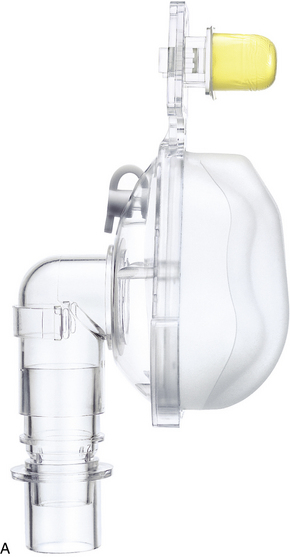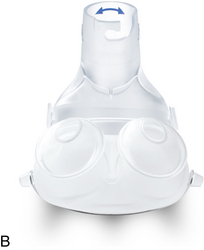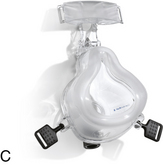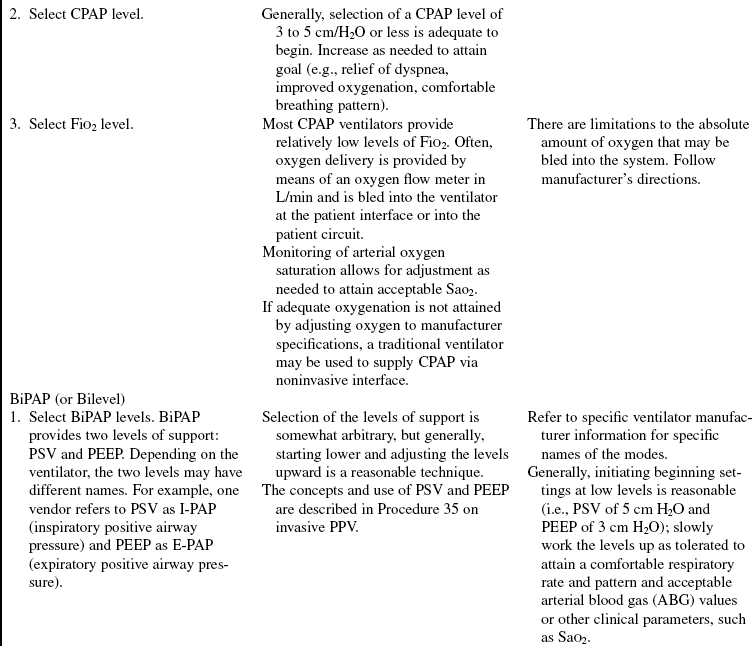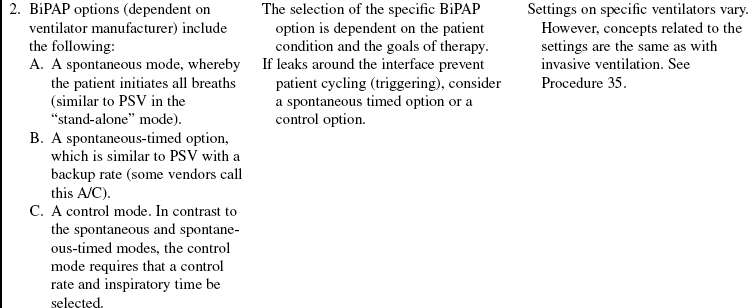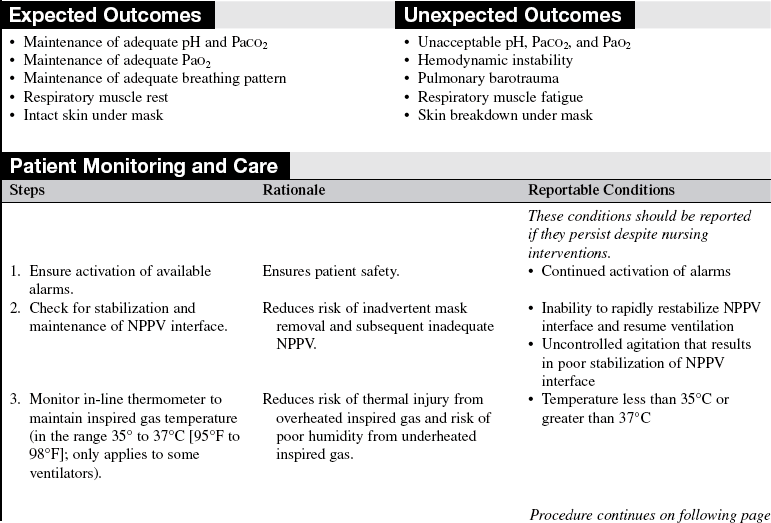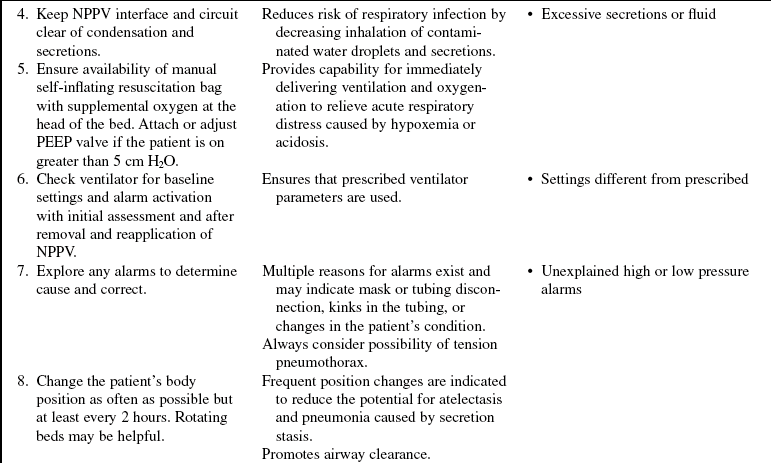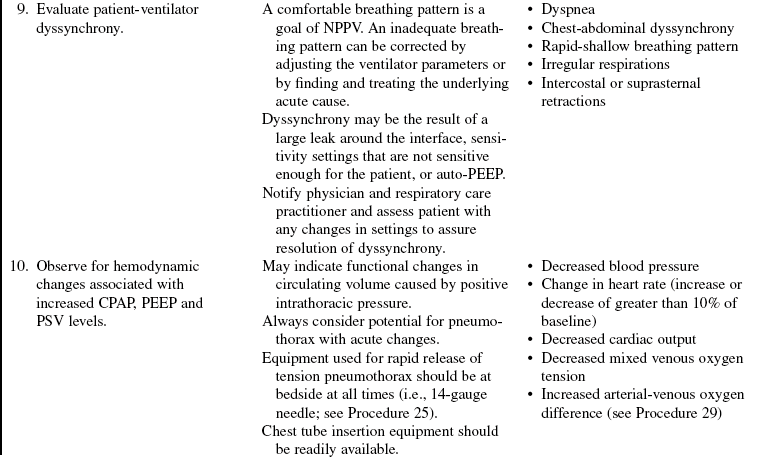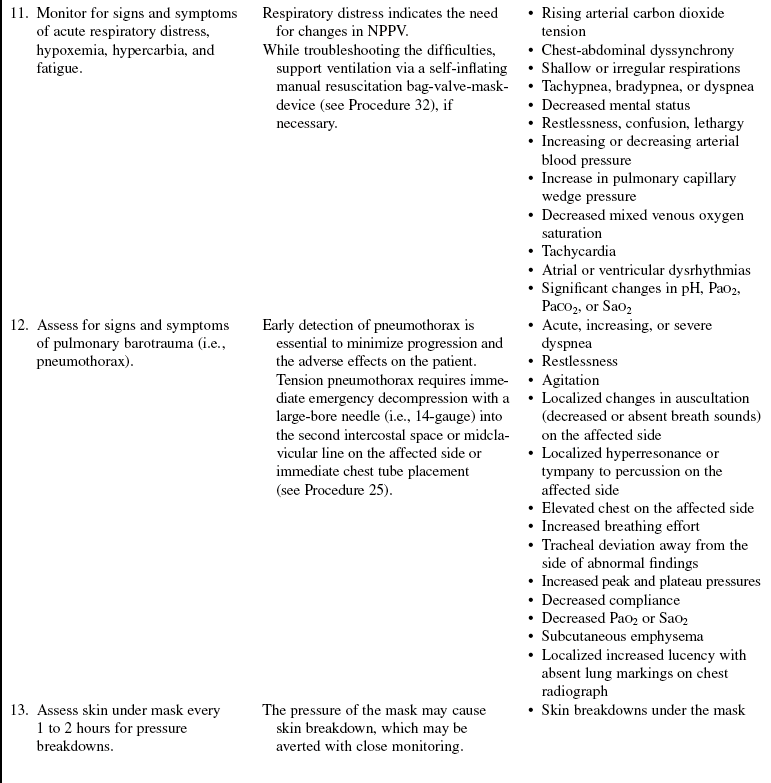Noninvasive Positive Pressure Ventilation: Continuous Positive Airway Pressure (CPAP) and Bilevel Positive Airway Pressure (BiPAP)
PREREQUISITE NURSING KNOWLEDGE
• Invasive mechanical ventilation through an endotracheal tube or tracheostomy tube has been the mainstay of ventilatory support in patients with severe oxygenation and ventilation problems. However, the successful use of noninvasive positive pressure ventilation (NPPV), specifically continuous positive airway pressure (CPAP), in the 1980s to treat obstructive sleep apnea (OSA), was followed by its use to treat other chronic respiratory conditions as well.
• The addition of positive pressure ventilation in the form of bilevel positive airway pressure (BiPAP; pressure support ventilation plus positive end-expiratory pressure [PSV plus PEEP]) or conventional ventilation modes such as assist-control (A/C) provided through noninvasive ventilator-patient interfaces allowed for extension of NPPV to patients with hypercarbia and other acute and critical care applications.1,3–5
• NPPV is attractive for many reasons, including the avoidance of complications associated with invasive ventilation such as aspiration, pneumothorax, patient discomfort, and contamination of the airway and subsequent infection.
• However, the use of NPPV, especially in the critically ill or acutely ill patient, is time and effort intensive, especially initially when the selection of interface, mode settings, and other medical therapeutics are addressed. In addition, careful selection of patients and identification of relative and absolute contraindications to the use of NPPV are essential to avoid negative outcomes.
• Potential applications, exclusion criteria, and other aspects related to the use of NPPV are addressed subsequently and in the procedure.
Potential Applications for the Use of NPPV
• Obstructive sleep apnea. Traditionally, CPAP has been used in OSA to provide a pneumatic splint to the upper airway to prevent obstruction during sleep. BiPAP provides both PEEP and PSV during inspiration, both assisting with ventilation and treating hypercarbia.1,3,4 In some patients with OSA, this method is more effective, especially in those with nighttime hypoventilation. Patients with OSA admitted to a critical care unit may need intubation and higher levels of ventilatory support than is possible to provide with NPPV. Others have conditions that may be managed on NPPV, but support levels may be higher than home NPPV settings.
• Cardiogenic pulmonary edema. Many studies have been accomplished that demonstrate the efficacy of NPPV in patients with congestive heart failure (CHF) and pulmonary edema.10,11,14,16,17,19,21,24,25 In these patients, the positive pressure results in preload and afterload reduction and restoration of functional residual capacity. NPPV works synergistically with diuretics and other medical interventions, enhancing their effect. In patients with a chronic condition, such as those with OSA and CHF, treatment with CPAP for 1 month significantly decreased systolic blood pressure (BP) and improved left ventricular function.14 Improved quality of life appears to be an additional benefit.16 In the patient with an acute illness, studies with PSV through a face mask suggest that intubation may be prevented10 and that its early use also accelerates improvement in partial pressure of arterial oxygen/fraction of inspired oxygen (PaO2/FiO2) ratio, partial pressure of arterial carbon dioxide (PaCO2), dyspnea, and respiratory rate but not overall clinical outcomes.17 Interestingly, both CPAP and BiPAP appear to be equally effective in this patient population. In an randomized controlled trial (RCT) that compared the modes, both resulted in improved vital signs and arterial blood gas values and a lower rate of endotracheal intubation without cardiac ischemic complications.19 In the patient with an acute illness with cardiogenic pulmonary edema, the evidence supports a trial of NPPV with exception of those with extubation failure.4,23
• Acute or chronic respiratory failure (i.e., chronic obstructive pulmonary disease [COPD]). A high level of evidence supports the use of trial of NPPV in hypercapnic respiratory failure (particularly related to COPD).4 The only exception to this recommendation is in those with extubation failure.4 NPPV in patients with hypercapnia has been effective in reducing intubation rates17,23 and is associated with reductions in mortality and the need for invasive mechanical ventilation but not hospital length of stay.20
• Acute hypoxemic respiratory failure. Although some studies suggest that NPPV may be effective in selected instances of acute hypoxemic respiratory failure,2,11–13 perhaps the most compelling category for use is in patients with immunosuppression with pneumonia.12,22 In an RCT, early initiation of NPPV in these patients was associated with significant reductions in the rates of endotracheal intubation and serious complications. In addition, an improved likelihood of survival to hospital discharge was found.12 Unfortunately, with this exception, study findings have not conclusively supported the routine use of NPPV in hypoxemic respiratory failure patient populations.15,23
• To prevent reintubation after extubation. The use of NPPV has not been associated with prevention of need for reintubation or a reduction in mortality in patients with respiratory failure after extubation.5,7 However, careful selection of patients for NPPV after extubation did appear to improve outcomes in one RCT.9 In this study, the early use of NPPV (BiPAP) in those “at risk of respiratory failure following extubation”9 resulted in a decreased intensive care unit mortality. The risk factors included cardiac failure as cause of intubation, age more than 65 years, and increased severity of illness as identified by an Acute Physiology and Chronic Health Evaluation (APACHE) II score of more than 12 on the day of extubation.9
• Failure to wean. Although this population is underrepresented in the literature, at least one recent study suggests that the use of NPPV in patients with failure to wean successfully for three consecutive days may show better outcomes than in those weaned in a more traditional manner. In the study, BiPAP was used after early extubation and resulted in fewer days of mechanical ventilation and length of stay, less need for tracheostomy, lower incidence of complications, and improved survival.8
• Invasive ventilation not desired: Palliative or end-of-life care. In 2007, the Society of Critical Care Medicine’s Palliative Noninvasive Positive Pressure Ventilation Task Force proposed recommendations for the use of NPPV for patients and families of the patients wishing to forego endotracheal intubation.6 The recommendations focus on ensuring that patients and families understand the goals of the therapy (reduction of air hunger, etc), the criteria for determining success or failure of the NPPV, that the healthcare providers be experienced in the use of NPPV and the setting appropriate.6 The use of the therapy for end-of-life care is controversial because some believe it unduly prolongs death and others maintain it is a means of decreasing uncomfortable symptoms such as dyspnea.
Potential Exclusions for the Use of NPPV
• Status asthmaticus. Because of the instability of these patient conditions and the difficulty inherent in providing ventilatory support during the acute phase (e.g., preventing hyperinflation, auto-PEEP, and barotrauma), the use of NPPV is not recommended. Few studies are available supporting its use in this category of patient condition.
• Hemodynamic instability. Generally, this condition refers to patients with high vasopressor requirements or other supportive therapies. These patients need full ventilatory support to ensure acid-base stability and the adequacy of oxygenation and ventilation.
• Inadequate airway protective reflexes. Cough and swallow are essential for airway protection. Absence of these reflexes puts the patient at risk for aspiration.
• Encephalopathy or coma. As noted previously, the inability to protect the airway or remove a mask (especially full face masks) when necessary puts the patient at risk for aspiration.
• Mask fit or intolerance (claustrophobia, facial deformities, and occasionally, the absence of teeth). Different noninvasive options are available and should be considered if intolerance of masks (nasal or full face) or other interfaces is evident.
• Excessive secretions. The presence of secretions necessitates that the patient be able to effectively clear the airway. When excessive secretions are present, the work associated with effective airway clearance may quickly overwhelm the patient’s endurance and result in respiratory failure.
• Severe agitation. Agitation makes adjustment to the use of a noninvasive interface difficult. Further, leaks are increased when the interface is displaced, which makes ventilation unreliable and ineffective.
• High FiO2 requirements. Most of the NPPV ventilators do not provide a high level of FiO2 (this varies with the make, model, and manufacturer of the ventilator). In these cases, the patient may need invasive ventilation or NPPV with a conventional ventilator to ensure provision of the required FiO2.
NPPV Interfaces
• Noninvasive interfaces are selected on the basis of patients’ unique facial features, patient preferences, comfort, ease of use, availability, and provider experience and preference and include full face masks, nasal masks, nasal pillows, and helmets. Of these, full head helmets are the least commonly used (and not discussed further in this procedure) but may be more prevalent in the future as experience with the interfaces increases.18 See Fig. 28-1 for NPPV interfaces.
Potential Causes of Failure of NPPV
• When NPPV fails, as evidenced by lack of improvement or further deterioration, invasive ventilation is necessary. Equipment and personnel to ensure safe intubation and application of invasive ventilation are necessary and should be ensured (see Procedures 2, 3, 35) Some potential causes of NPPV failure follow:
• Poor patient selection. See previous potential applications and exclusions.
• Mask intolerance and leaks. As noted previously, careful selection of the interface is essential to ensure success. In addition to patient facial characteristics, the actual process of applying the mask may be the reason for failure. In general, application of the mask as gently and gradually as possible is important to help the patient acclimate. Simultaneous and gradual adjustment of the mode parameters is a useful technique if the situation allows for the use of such a strategy. If mask leaks are present, patient-generated cycling may be adversely affected and result in dyssynchrony. Time-cycled modes may be helpful in these cases. Other mask complications that limit use include gastric distention and vomiting, nasal congestion, eye irritation from leaks, discomfort, claustrophobia, and nasal and facial skin breakdown.
• Development of serious complications. These complications include myocardial infarction, gastrointestinal bleeding, and sepsis.
• Limitation of the ventilator. Most NPPV ventilators do not provide for the delivery of high FiO2, as noted previously. Flow capabilities may also vary and, if inadequate, result in dyssynchrony. In one study that compared bilevel devices with standard adult critical care ventilators, the bilevel devices were found to provide superior flow delivery.14
• Patient ventilator dyssynchrony. Many reasons for dyssynchrony exist and may include both physical and mechanical reasons such as auto-PEEP, worsening condition or other complications, and ventilator limitations (e.g., CO2 elimination from partial rebreathing with some NPPV circuits).
EQUIPMENT
• Noninvasive interface (see Fig. 28-1)
• Pulse oximetry (oxygen saturation of hemoglobin measured with pulse oximetry: SpO2)
• Self-inflating manual resuscitation bag-valve-mask device
• Intubation equipment and endotracheal tubes, should NPPV be unsuccessful (see Procedures 2, 3)
• Personal protective equipment (gloves, mask, goggles, gown, as appropriate)
PATIENT AND FAMILY EDUCATION
• Explain the procedure and the reason NPPV is being initiated to the patient and family.  Rationale: Communication and explanations for therapy are cited as important needs of patients.
Rationale: Communication and explanations for therapy are cited as important needs of patients.
• Discuss the potential sensations the patient will experience, such as relief of dyspnea, lung inflations, noise of ventilator operation, and alarm sounds.  Rationale: Knowledge of anticipated sensory experiences reduces anxiety and distress.
Rationale: Knowledge of anticipated sensory experiences reduces anxiety and distress.
• Encourage the patient to relax.  Rationale: This encouragement promotes general relaxation, oxygenation, and ventilation.
Rationale: This encouragement promotes general relaxation, oxygenation, and ventilation.
• Explain that the patient will be able to speak but that this should be kept to a minimum to ensure effective application of the mode. Establish a method of communication in conjunction with the patient and family before initiation of NPPV.  Rationale: Ensuring the patient’s ability to communicate is important to alleviate anxiety.
Rationale: Ensuring the patient’s ability to communicate is important to alleviate anxiety.
• Teach the patient and family how to use the call system and to help the patient with minor activities such as suctioning the mouth.  Rationale: Family members have identified the need and desire to help in the patient’s care.
Rationale: Family members have identified the need and desire to help in the patient’s care.
• Provide the patient and family with information on the use of NPPV and anticipated goals of the therapy.  Rationale: Knowledge of the prognosis, probable outcome, or chance for recovery is cited as an important need of patients and families.
Rationale: Knowledge of the prognosis, probable outcome, or chance for recovery is cited as an important need of patients and families.
• Offer the opportunity for the patient and family to ask questions about NPPV.  Rationale: The ability to ask questions and have questions answered honestly is cited consistently as the most important need of patients and families.
Rationale: The ability to ask questions and have questions answered honestly is cited consistently as the most important need of patients and families.
PATIENT ASSESSMENT AND PREPARATION
Patient Assessment
• Assess for the following signs and symptoms of fatigue and impending acute ventilatory failure:
 Rising arterial carbon dioxide tension
Rising arterial carbon dioxide tension
 Shallow or irregular respirations
Shallow or irregular respirations
 Tachypnea, bradypnea, or dyspnea
Tachypnea, bradypnea, or dyspnea
 Restlessness, confusion, or lethargy
Restlessness, confusion, or lethargy
 Rationale: These signs and symptoms demonstrate failure to adequately ventilate with NPPV. If the situation is not corrected, the patient may need intubation and initiation of PPV. While PPV is considered and assembled, support ventilation via a manual self-inflating resuscitation bag, if necessary.
Rationale: These signs and symptoms demonstrate failure to adequately ventilate with NPPV. If the situation is not corrected, the patient may need intubation and initiation of PPV. While PPV is considered and assembled, support ventilation via a manual self-inflating resuscitation bag, if necessary.
• Assess for the following signs and symptoms of inadequate oxygenation:
 Decreasing arterial oxygen tension
Decreasing arterial oxygen tension
 Intercostal and suprasternal retractions
Intercostal and suprasternal retractions
 Rationale: If hypoxemia noted by a saturation of arterial oxygen (SaO2) is less than 90% or PaO2 less than 60 mm Hg) cannot be immediately corrected on NPPV, the patient may need invasive PPV. While PPV is considered and assembled, provide 100% oxygen via manual resuscitation bag and mask.
Rationale: If hypoxemia noted by a saturation of arterial oxygen (SaO2) is less than 90% or PaO2 less than 60 mm Hg) cannot be immediately corrected on NPPV, the patient may need invasive PPV. While PPV is considered and assembled, provide 100% oxygen via manual resuscitation bag and mask.
• Determine pH and arterial carbon dioxide tension.  Rationale: Acute ventilatory failure is confirmed by an uncompensated respiratory acidosis. Ventilatory failure is an indication for immediate adjustment of settings and possibly invasive PPV. See previous bullet.
Rationale: Acute ventilatory failure is confirmed by an uncompensated respiratory acidosis. Ventilatory failure is an indication for immediate adjustment of settings and possibly invasive PPV. See previous bullet.
Patient Preparation
• Verify correct patient with two identifiers.  Rationale: Prior to performing a procedure, the nurse should ensure the correct identification of the patient for the intended intervention.
Rationale: Prior to performing a procedure, the nurse should ensure the correct identification of the patient for the intended intervention.
• Ensure that the patient understands pre-procedural teachings. Answer questions as they arise, and reinforce information as needed.  Rationale: This communication evaluates and reinforces understanding of previously taught information.
Rationale: This communication evaluates and reinforces understanding of previously taught information.
• Premedicate as needed.  Rationale: Cautious use of narcotics, sedatives, or anxiolytics may be necessary for comfort, to help allay anxiety, and to improve the patient’s tolerance of NPPV. However, the use of the drugs should not adversely affect spontaneous breathing or consciousness.
Rationale: Cautious use of narcotics, sedatives, or anxiolytics may be necessary for comfort, to help allay anxiety, and to improve the patient’s tolerance of NPPV. However, the use of the drugs should not adversely affect spontaneous breathing or consciousness.
References
1. Annane, D, Orlikowaski, D, Chevret, S, et al, Nocturnal mechanical ventilation for chronic hypoventilation in patients with neuromuscular and chest wall disorders. Cochrane Database Systematic Review 4, 2007. [CD001941].
2. Antonelli, M, Conti, G, Esquinas, A, et al. A multiple-center survey on the use in clinical practice of noninvasive ventilation as a first-line intervention for acute respiratory distress syndrome. Crit Care Med. 2007; 35:18–25.
3. Burns, KE, Adhikar, NK, Keenan, SP, et al, Use of non-invasive ventilation to wean critically ill adults off invasive ventilation. meta analysis and systematic review. BMJ 2009; 338:b728.
4. Caples, SM, Gay, PC, Noninvasive positive pressure ventilation in the intensive care unit. a concise review. Crit Care Med 2005; 33:2651–2658.
5. Crummy, F, Naughton, MT, Non-invasive positive pressure ventilation for acute respiratory failure. justified or just hot air. Intern Med J 2007; 37:112–118.
6. Curtis, JR, Cook, DJ, Sinuff, T, et al, the Society of Critical Care Medicine’s Palliative Noninvasive Positive Pressure Ventilation Task Force. Noninvasive positive pressure ventilation I critical and palliative care settingsunderstanding the goals of therapy. Crit Care Med 2007; 35:932–939.
![]() 7. Esteban, A, Frutos-Vivar F, Ferguson, ND, et al. Noninvasive positive-pressure ventilation for respiratory failure after extubation. N Engl J Med. 2004; 350:2452–2460.
7. Esteban, A, Frutos-Vivar F, Ferguson, ND, et al. Noninvasive positive-pressure ventilation for respiratory failure after extubation. N Engl J Med. 2004; 350:2452–2460.
![]() 8. Ferrer, M, Esquinas, A, Arancibia, F, et al, Noninvasive ventilation during persistent weaning failure. a randomized controlled trial. Am J Respir Crit Care Med 2003; 168:70–76.
8. Ferrer, M, Esquinas, A, Arancibia, F, et al, Noninvasive ventilation during persistent weaning failure. a randomized controlled trial. Am J Respir Crit Care Med 2003; 168:70–76.
9. Ferrer, M, Valcencia, M, Nicolas, JM, et al. Early non-invasive ventilation averts extubation failure in patients at risk; a randomized trial. Am J Respir Crit Care Med. 2006; 173:164–170.
![]() 10. Giacomini, M, Iapichino, G, Cigada, M, et al. Short-term noninvasive pressure support ventilation prevents ICU admittance in patients with acute cardiogenic edema. Chest. 2003; 123:2057–2061.
10. Giacomini, M, Iapichino, G, Cigada, M, et al. Short-term noninvasive pressure support ventilation prevents ICU admittance in patients with acute cardiogenic edema. Chest. 2003; 123:2057–2061.
11. Gray, A, Goodacre, S, Newby, DE, et al. Noninvasive ventilation in acute cardiogenic pulmonary edema. N Engl J Med. 2008; 359:142–151.
![]() 12. Hilbert, G, Gruson, D, Vargas, F, et al. Noninvasive ventilation in immunosuppressed patients with pulmonary infiltrates, fever and acute respiratory failure. N Engl J Med. 2001; 344:481–487.
12. Hilbert, G, Gruson, D, Vargas, F, et al. Noninvasive ventilation in immunosuppressed patients with pulmonary infiltrates, fever and acute respiratory failure. N Engl J Med. 2001; 344:481–487.
13. Honrubia, T, Garcia-Lopez FJ, Franco, N, et al, Noninvasive vs conventional mechanical ventilation in acute respiratory failure. a multicenter, randomized controlled trial. Chest 2005; 128:3790–3791.
![]() 14. Kaneko, Y, Floras, JS, Usui, K, et al. Cardiovascular effects of continuous positive airway pressure in patients with heart failure and obstructive sleep apnea. N Engl J Med. 2003; 348:1233–1241.
14. Kaneko, Y, Floras, JS, Usui, K, et al. Cardiovascular effects of continuous positive airway pressure in patients with heart failure and obstructive sleep apnea. N Engl J Med. 2003; 348:1233–1241.
![]() 15. Keenan, SP, Sinuff, T, Cook, DJ, et al. Does noninvasive positive pressure ventilation improve outcome in acute hypoxemic respiratory failure? A systematic review. Crit Care Med. 2004; 32:2516–2523.
15. Keenan, SP, Sinuff, T, Cook, DJ, et al. Does noninvasive positive pressure ventilation improve outcome in acute hypoxemic respiratory failure? A systematic review. Crit Care Med. 2004; 32:2516–2523.
![]() 16. Mansfield, DR, Golloghy, NC, Kaye, DM, et al. Controlled trial of continuous positive airway pressure in obstructive sleep apnea and heart failure. Am J Respir Crit Care Med. 2004; 169:361–366.
16. Mansfield, DR, Golloghy, NC, Kaye, DM, et al. Controlled trial of continuous positive airway pressure in obstructive sleep apnea and heart failure. Am J Respir Crit Care Med. 2004; 169:361–366.
![]() 17. Nava, S, Carbone, G, DiBattista, N, et al, Noninvasive ventilation in cardiogenic pulmonary edema. a multicenter randomized trial. Am J Respir Crit Care Med 2003; 168:1432–1437.
17. Nava, S, Carbone, G, DiBattista, N, et al, Noninvasive ventilation in cardiogenic pulmonary edema. a multicenter randomized trial. Am J Respir Crit Care Med 2003; 168:1432–1437.
18. Navalesi, P, Costa, R, Ceriana, P, et al, Non-invasive ventilation in chronic obstructive pulmonary disease patients. helmet versus facial mask. Intensive Care Med 2007; 33:74–81.
![]() 19. Park, M, Sangean, MC, Volpe M de S, et al. Randomized, prospective trial of oxygen, continuous positive airway pressure, and bilevel positive airway pressure by face mask in acute cardiogenic pulmonary edema. Crit Care Med. 2004; 32:2407–2415.
19. Park, M, Sangean, MC, Volpe M de S, et al. Randomized, prospective trial of oxygen, continuous positive airway pressure, and bilevel positive airway pressure by face mask in acute cardiogenic pulmonary edema. Crit Care Med. 2004; 32:2407–2415.
![]() 20. Peter, JV, Moran, JL, Phillips-Hughes, J, et al, Noninvasive ventilation in acute respiratory failure. a meta-analysis update. Crit Care Med 2002; 30:555–562.
20. Peter, JV, Moran, JL, Phillips-Hughes, J, et al, Noninvasive ventilation in acute respiratory failure. a meta-analysis update. Crit Care Med 2002; 30:555–562.
21. Peter, JV, Moran, JL, Phillips-Hughes J, et al, Effect of non-invasive positive pressure ventilation (NIPPV) on mortality in patients with acute cardiogenic pulmonary oedema. a meta-analysis. Lancet 2006; 367:1155–1163.
22. Rabitsch, W, Staudinger, T, Locker, GJ, et al, Respiratory failure after stem cell transplantation. improved outcome with non-invasive ventilation. Leuk Lymphoma 2005; 46:1151–1157.
23. Schettino, G, Altobelli, N, Kacmarek, RM, Noninvasive positive–pressure ventilation in acute respiratory failure outside clinical trials. experience at the Massachusetts General Hospital. Crit Care Med 2008; 36:441–447.
24. Vital, FM, Saconato, H, Ladeira, MT, et al. Non-invasive positive pressure ventilation (CPAP or bilevel NPPV) for cardiogenic pulmonary edema. Cochrane Database Systematic Review. 16, 2008. [CD005351].
25. Winck, JC, Azevedo, LF, Costa-Pereira A, et al, Efficacy and safety of non-invasive ventilation in the treatment of acute cardiogenic pulmonary edema. a systematic review and meta-analysis. Crit Care 2006; 10:R69.
Pierce, LNB, Invasive and noninvasive modes and methods of mechanical ventilationBurns SM, ed.. AACN protocols for practice. care of mechanically ventilated patients. ed 2. Jones and Bartlett Publishers, Boston, 2007.
Pierce, LNB, Management of the mechanically ventilated patient. ed 2. Elsevier, St Louis, 2007.
Tobin, MJ. Principles and practice of mechanical ventilation, ed 2. New York: McGraw-Hill, 2006.

